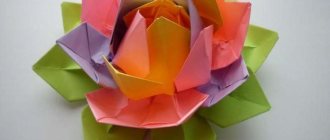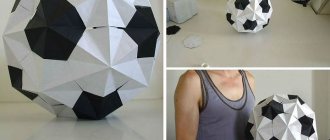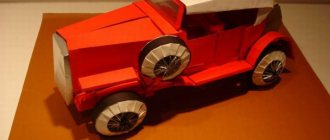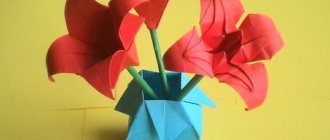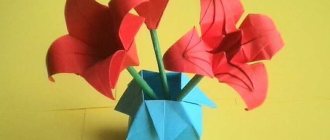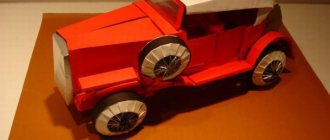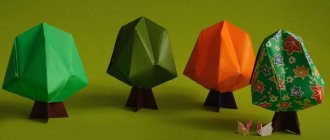Full of grace and beauty, swans are an age-old symbol of romance. Find out, how to make a swan out of paper with your own hands, which will be a wonderful decoration for any holiday, a nice gift and just a source of good mood. Mostly models made using the origami technique are presented here.
An origami paper swan is one of the most popular origami models, with varying degrees of complexity. This article contains examples mostly aimed at beginners, with a few easy folds that anyone can make, even children and novice origami enthusiasts. You will also find options on how to make a swan from modules and a beautiful paper craft, a swan on the lake.
Swan made of modules. Scheme.
Let's start making a swan from modules:
1. Make the first two rows. Place the three modules as shown in the picture.
Insert the corners of two triangular modules into the pockets of the third. You will get this design.
2. Prepare two more modules and insert them into the structure made earlier.
3. In the same style we connect two new modules. But this design is quite unstable and can very easily fall apart. In order for everything to work out as it should, you should collect three rows at once.
4. Add a third row and make the structure even stronger.
The design should look like this. One row of it is made of 30 modules.
5. Just like you did the third row, do the fourth and fifth.
6. Now you need to carefully take the entire structure with two fingers and press on its middle with your thumbs so that it turns out
7. Now bend the edges of the structure upward to get the shape shown in the picture.
This is what it looks like from the side.
And here's what it looks like from below.
8. We put on the 6th row of modules in the same way as before.
9. When Row 7 begins, get ready to give your paper swan wings. First you need to attach 12 modules of the eighth row to the structure. Next, skip two modules and attach 12 more modules. Where you missed 2 modules will be the neck, and in the other empty area you will build the tail.
10. Start building the 9th row, reducing each swan wing by one triangle.
This is what it looks like from the side
11. Continue building the wings, decreasing the row by one module until there is only one module left.
12. Making the swan's tail. Also reduce the row by one module.
13. Making the neck and head. Prepare 19 white and 1 red modules, in which you need to glue the corners to make a beak. To make a neck, you first need to arrange two modules as shown in the picture, and then insert the corners of one module into the pockets of the other.
Next, we assemble the swan’s neck in the same style. When assembling, try bending the structure with a crochet hook.
14. The final touch is to place the neck on the remaining two corners between the swan’s wings.
That's all!
Tail
The third internal structure is the smallest. A circle of 12 modules is built in 6 rows. From the 7th, the number of parts gradually decreases and the structure tapers towards the top, forming a tail.
These 3 parts need to be assembled into a single composition. A stand of two rows of modules is first glued to the bottom of the largest part for stability.
Rainbow swan made of modules
This incredibly beautiful rainbow swan is very easy to put together and requires 459 modules, which is actually not that many compared to other triangular module designs.
You can choose the color yourself, for example, you can make the beak from red modules, the body from white, and the wings, for example, from black.
You can make this rainbow swan with your children; they will really enjoy the whole process and will be happy with the final result.
This is interesting
Swans are the closest relatives of geese and, together with them, belong to the Duck family. There are 7 known species of these beautiful birds, which differ in size and color. The mute swan is considered the largest - individual individuals can weigh up to 22 kg, and their wingspan exceeds 3 m. Two other species are slightly behind the record holder: the whooper and the trumpeter. Swans are recognized as the largest waterfowl in Europe.
It is known that they create a pair for life, that is, for about 20 - 30 years. “Swan fidelity” is not a myth, but a unique natural phenomenon. Partner birds follow each other everywhere. Together they build a nest, care for the chicks, fly away to warmer regions and return. If one of the swans dies, the other spends several more years alone before finding a new partner.
The longest-necked ones are black swans, endemic to Australia. On other continents they are bred artificially. Before Europeans first set foot on Australian soil, it was not even thought that swans could have plumage other than snow-white. As for the neck, it is quite long in all species, allowing it to reach algae, small fish and shellfish at great depths.
Interestingly, all wild mute swans in Great Britain belong to the ruling royal family. The meat of these birds is considered an exquisite delicacy and is served only at the royal table. “Mere mortals” do not have the right to feast on such game, which is only for the benefit of the population. Swans have few natural enemies, but human activity has brought some species to the brink of extinction.
Majestic birds, despite their impressive size, are excellent flyers and reach speeds of up to 60 km/h. On water they move even faster and are able to outrun a motor boat at short distances. Swans are quite aggressive during the mating season, defending their territory from outsiders. They swoop down on an object that they perceive as a threat, beat their wings, hiss or scream, depending on the species. Therefore, you should not approach the swan’s nest; it is better to admire the beautiful birds from afar, so as not to overshadow this meeting.
Rainbow swan made of triangular modules. Scheme.
1. Prepare red paper modules using rectangles measuring 4 by 6 cm.
2. Assembling the modules. Connect the three modules by inserting the corners of the first two into the pockets of the third. You should end up with a basic element like this.
3. Two more modules need to be attached to the sides of our element.
Using the same scheme, you need to make a ring of 2 rows, each consisting of 30 modules. Close the ring (see picture).
4. The third, fourth and fifth row should be added in a checkerboard pattern using orange triangles.
5. Carefully turn the workpiece inside out. Your design should now look like this
If you turn the design upside down, it will look like this
6. Making wings. To do this, you need to start adding the 6th row, which also consists of 30 modules, but now yellow. Choose the side where you are going to make the swan's head. Find two corners from two modules from the sixth row - there will be a neck there.
Start to the left and right of these two modules to build the 7th row, also yellow. Both on the left and on the right you should have 12 modules, with 2 spaces between them.
Continue adding modules to the sides, reducing each row by 2 triangles.
8. Make the tail of the module in the same way.
9. Making the neck of a paper swan. Insert one module into the other and continue to build up the swan's neck, giving it the desired bend.
10. Making a stand. You need to make two rings connecting the modules, just like the neck.
Materials and tools
Origami literally means “folded paper” in Japanese. To fold most figures, special thin paper in the shape of a square is used, but you can also create interesting crafts from ordinary printer paper.
To make a paper swan you will need scissors, paper and a little imagination.
Double swan made of modules
You can give this swan made of triangular modules to a loved one or friend, and there can be any reason.
Making it more difficult than previous swans
, but it will be larger and more magnificent.
Prepare a stack of A4 sheets and patience
, since it is a very important element in the manufacture of many modules - but if you have already seen the picture, you understand this.
You don’t have to do everything at once in one day, you can stretch the process
.
To create a double swan you will need exactly 1502 modules. You can make it from white paper, but of course if you add a few details, for example, pink or red (you can choose any color), then it will take on a beautiful color, but then prepare 1322 white and 180 colored modules
.
The whole process is divided into 3 separate stages.
Children's craft
Such a simple work, as in the photo below, can be planned in the senior group of kindergarten during manual labor classes. The teacher cuts out a template of the contours of the bird from thick cardboard. Children trace it twice with a simple pencil and glue both parts together, leaving a small strip at the bottom unused. At this point, both elements move apart in opposite directions. Thanks to this procedure, the swan perfectly maintains an upright position.
How to make a paper swan next? A rectangular sheet of paper is folded like an accordion, inserted into a slot in the center of the body exactly in the middle, and the edges are glued together. Be sure to manually spread the paper fan in all directions. All that remains is to decorate the craft with small details, gluing on the eyes and red beak of the bird.
Swan made of triangular modules. Scheme. Stage I.
1. As usual, start connecting the 2 modules as shown in the picture.
2. Now connect another 60 (i.e. 2 rows of 30) modules that go in a circle. You should end up with a design like this.
3. Make a few more rows so that their number reaches 15. During the assembly process, you need to bend the structure inward once and continue adding modules, gradually bending and stretching the entire structure.
4. Assemble the tail and wings. A total of 6 modules are needed for the neck (in the figure, 6 modules are divided into 2 pink and 4 white) and 4 for the tail. The tail is located opposite the neck.
To assemble the neck, simply remove 1 module at a time, i.e. the next row of the neck will have 5 modules, then 4, 3 and stop at 2 modules.
To assemble the tail in the same style, we assemble modules, starting with 4 and reaching one at the top.
5. Assembling the wings. For the first row of wings you will need 10 modules.
When you start making the second row of wings, you need to insert the module from the tail side as shown in the picture.
6. Continue attaching the modules, using 10 pieces for each row. You need to get to the 10th row.
7. After 10 rows, you need to continue making wings, but this time reduce them one module at a time, i.e. each subsequent row will have 1 less module. Make sure that the rows of the wing on the right are equal in height to the rows of the left wing.
8. You should have a design like this from 770 parts.
9. To make your structure more stable, add modules to the base as shown in the picture to create a stand. You can attach these modules with glue. At this stage, you also need to attach all the modules evenly so that the swan stands well. Make another row like this (there are two in total).
Simple model
Beginning origami artists should pay attention to the origami swan, which will be ready in just a few steps. Despite its simplicity, the model looks great in wedding garlands or as a stand for Japanese chopsticks. This origami swan is based on the basic Kite shape.
Step-by-step instruction:
- We place a 15x15 cm square with the wrong side up and fold it diagonally. Let's reveal.
- We bring the lower edges to the central axis. It turns out to be “Kite”.
- We turn the model over.
- Fold the bottom edges toward the center again.
- We raise the lower acute corner to the blue point.
- Iron the fold line.
- We lower the sharp end down to form a beak.
- The swan is almost ready.
- Fold the figure in half into a “mountain”.
- Grasping the area indicated by the circle with your fingers, pull the neck up along the arrow.
- We bend the “beak” forward and backward at an angle.
- Then we make a reverse fold, placing it at 90°.
Other options
A double origami model of a swan with a chick is good for decorating a card for Mother's Day or March 8th. Assembly diagram:
The ultra-light 7-step model is suitable for children aged 6 – 7 years.
Double swan made of triangular modules. We collect all the details.
The time has come to put everything together, i.e. insert the smaller piece inside the larger one.
If the inner wings are difficult to insert, they need to be inserted slowly, gradually moving the parts of the larger part apart.
With the third part, the same problems may arise. You will have to push it in little by little. As a last resort, place the part on glue.
And to make the neck you should start assembling with 3 or 4 modules. How the swan's neck bends is up to you. You can put the first few rows of the neck on glue to make the structure more durable.
You can decorate your swan to your liking, using ribbons, for example, but don't overdo it.
Neck
The final touch is making the neck. It is formed from 3-4 modules of the first part. This is a delicate thing, so you can use a little glue to make it secure. You can draw eyes or use special blanks. To decorate the craft, beads and any other decorative materials are useful.
The craft will decorate the interior, and a photo of a homemade origami swan will get a lot of likes on social networks.
Assembling a swan from modules
1. We build the torso. To do this you need to assemble a chain of triangles (see picture). When you close the chain, you will have 2 rows of modules, each with 43 triangles.
2. Starting from the 3rd row, you need to attach the modules in a checkerboard pattern. For the body you need 12 rows.
3. Make the breast and wing. The breast base has 9 modules. In one of the pictures they are marked with a black marker. As you lay out the rows, each next one should have 1 less module until you have 3 modules left.
In order to start making the wing, you need to turn the modules the other way and attach them to the breast (see picture).
4. Take a careful look at the pictures - the row of wing modules that comes from the breast is reduced by one module, and at the end of each row you need to add one module (one pocket of this last module will be empty)
This is what it looks like from the inside.
5. You need to lay out 12 rows of 12 modules each, and from the 13th row, start removing 2 modules in each row (on the left and right sides of the row). The wing ends when 1 module remains.
This is what it looks like from the inside
6. Make the second wing in the same style.
7. Making a tail for the Black Prince. At the base of the tail there are 6 modules, which are turned upside down. Continue adding rows, decreasing each by 1 module. There should be one triangle left at the end. The picture on the right shows the inside of the tail.
8. Let's return to the swan's breast. We settled on three modules, and start making the neck of the paper swan from them. Alternate rows of 2-3 modules. There should be 19 rows in total.
9. Making the swan's head. Turn the modules over and start attaching them in a checkerboard pattern - one row is 3 modules, another is 2 modules, then again 3 and 2, and the head is ready.
10. Making the back of a swan. There are 15 modules attached to the base of the backrest. Build rows, decreasing by 1 module each time. Finish when there is one module left.
11. Making a stand. It consists of 3 rows of 61 modules, built in the form of a closed circle.
12. Paint the white swan black.
Before you start painting, you need to give the swan's wings and neck a certain curve. It is also worth mentioning once again that painting with black aerosol enamel is best done outdoors, since the fumes of such paint are poisonous.
Leave the stand white.
This is how the swan looks after painting.
13. Making white plumage. Use the white module to connect one module from the breast and one from the wing. In the same style, attach white modules along the edge of the wing, gradually moving upward, combining white and black triangles.
14. The same plumage should be done for the chest and tail.
15. To make the beak, use one white and one red module.
16. Using glue, attach the back to the swan. Attach the wide part to the breast, and the narrow part to the tail; add plastic eyes (if desired); glue the Black Prince onto the stand.
For newbies
This swan is perfect for people who are just learning new techniques. The model is quite simple. The sheet must be folded in half and unfolded. The right and left corners fold into the center. Then the tip bends upward.
To create the head, fold the end of the top layer down. Then fold it back, and pull your head up and out. If desired, the bottom can be opened slightly and the origami can be placed on a hard surface.
That's not all!
Of course, as many needlewomen as there are, so many ideas. We have offered you the simplest, most popular and “working” methods, but these are not all methods. And the best way you can come up with yourself!
Use your imagination. Choose the technique that suits you and add something of your own to it, imagine and create. After all, in creativity there can be no copies or clear patterns, but there should always be room for inspiration!


